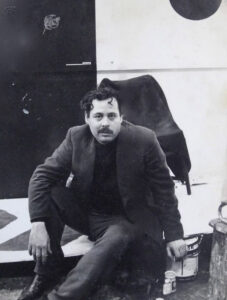A new BBC documentary airing next week revisits the famous 1966 case in Britain which prosecuted artist Stass Paraskos
In 1966, Cypriot artist Stass Paraskos was arrested for staging his exhibition Lovers and Romances at the Leeds College of Art. His purported offence, showing ‘lewd and obscene’ works, led to a raid and shutdown of the show by local police. He would be the last artist successfully prosecuted in Britain under the Vagrancy Act 1938.
The much-publicised case, which put Stass on the international art map, will be featured this week in an upcoming BBC2 programme hosted by Professor Mary Beard.
Titled Mary Beard’s Forbidden Art, the two-part documentary will explore “works that have been fought over, removed from view or simply ‘forbidden’” according to the BBC’s description. The first episode will feature Paraskos’ trial, which was a significant event in the British art world and seen as a major turning point in the battle against censorship.
“Stass was a little bit embarrassed about it,” his son Michael told the Sunday Mail. “People always wanted to talk about the trial, but that happened early in his career, but he preferred to talk about his later work.”
Papers at the time wrote that a police constable took offence after noticing two schoolgirls giggling in front of one of the paintings on show, which depicted a couple in a sexual act. As a result, the exhibition was raided, the painting and two sketches also deemed offensive seized, and the artist led to court.
“I would not regard them as being in any way indecent or obscene,” the then principal of Leeds College of Art Eric Taylor said of the offending paintings. “Only an uncultured and an uneducated mind could imagine this sort of thing.”
To Stass, it was all quite innocent, Michael said. “The whole point was that we were seeing a narrative of two people meeting, falling in love, and then making love.”
Stass himself told the Daily Mirror back in 1966 that he was “absolutely shocked” as the seized pictures were “quite wholesome”. “Of course they show men and women in the nude. What is wrong in that?”
Despite his own insistence that his art was not intended to ‘corrupt and deprave,’ and support from leading art world figures and then Home Secretary Roy Jenkins, Stass lost the case. This made him the last artist in Britain to be successfully prosecuted for obscenity under the Vagrancy Act 1838, which had been used earlier against the author DH Lawrence for Lady Chatterley’s Lover.
“It’s very important that it’s not forgotten, as it was a major event at the time,” Michael said, that made Stass an important figure in the British art world. At the same time, “it showed how significant Cypriot émigrés could be in changing the art world and beyond”.
The notorious court case turned Stass, who died in 2014, into an international celebrity, giving him more teaching opportunities and an invitation to take part in a group exhibition at London’s Institute of Contemporary Arts. Two colour sketches that led to his prosecution were acquired by the Tate Gallery in 2007, making him the only Cypriot artist with work in the prestigious collection.
In 2016, the Tetley gallery in Leeds staged a retrospective paying tribute to the original Lovers and Romances, which showed the offending works alongside archival material chronicling the trial, and later pieces by Stass.
Known in Cyprus as one of the most influential artists of his generation, Stass spent most of his life and career in England. The son of poor farmers, he was born in Anaphotia near Larnaca in 1933, and emigrated to Leeds at age 20 to work at his brother’s restaurant. Encouraged by members of the local art scene and tutor Harry Thubron, he enrolled for classes at the Leeds College of Art, befriending some of the most important artists of the time and eventually becoming a lecturer there.
After years of teaching art in several British universities and art schools, he returned to Cyprus in 1989 to run the Cyprus College of Art, the first art college in Cyprus, which he founded 20 years earlier.
His vision of an artist-led institution celebrating artistic and social freedom lives on today under the guidance of his daughter Margaret, welcoming art students and established artists from around the world.
Mary Beard’s Forbidden Art airs on BBC2 on Thursday February 3, at 9pm UK time








Click here to change your cookie preferences